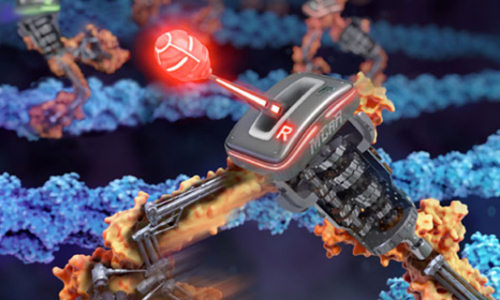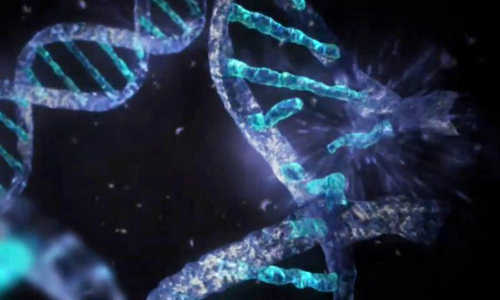Inside our cells, proteins known as myosins can act as a delivery service for biological materials. To better understand how molecular motors move, Stanford bioengineers have built experimental versions of the proteins, changing the way these transporters get around.
Led by Zev Bryant, an assistant professor of bioengineering at Stanford, a team of researchers has genetically engineered “mutant” myosins with new features such as gearshifts and improved traction. The group’s most recent findings are published in the January issue of Nature Nanotechnology, where they are highlighted alongside other studies of molecular motors.
“You look at biology, and you see motors that have diverse mechanical properties, and you want to understand how these arise,” Bryant said. “You test your understanding by trying to build something new.”
Molecular motors are a class of proteins that make up the moving machinery of cells. Myosins are one family of molecular motors. Some of them can shuttle biomolecules from one region of the cell to another.
These myosins move along microscopic filaments made of the protein known as actin. These actin filaments are one component of the cytoskeleton, or internal support structure of the cell.
Bryant wanted to test his understanding of how evolution has designed these myosin proteins to shuttle cellular freight. Funded by an NIH “New Innovator” Award, members of the group launched a series of experiments in 2008 that steered their myosin research in a new direction. They began engineering myosins with extra parts to give natural myosins new capabilities.
Natural myosins, for example, see actin filaments as one-way tracks. To better understand this one-directional motion, Bryant challenged his group to design mutant myosins that could move forward and backward on command.
The researchers engineered myosin motors with extra components that behaved like a molecular gearshift. In a 2012 Nature Nanotechnology report, the researchers showed that they could shift their mutant myosin motion between forward and reverse.
However, these two-way myosins had trouble hanging onto their actin tracks.
“When we engineer motors to have new capabilities, we often sacrifice some capabilities that they already had,” Bryant said.
So the group focused on creating motors that excelled at hanging on.

Natural myosins that shuttle molecules in cells – and the Bryant lab’s original bidirectional mutants – have two molecular arms. These arms terminate in two molecular hands. These hands attach to the actin filaments.
Myosin proteins can move along these filaments, hand over hand, like a person on monkey bars. The Stanford team designed three- and four-handed versions of myosins, hypothesizing that adding extra hands would help stabilize the mutant motors and enable them to better grip the monkey bars.
But, “we didn’t know if adding those extra elements would muck everything up,” said doctoral student Tony Schindler, first author of the January Nature Nanotechnology report.
The team members made these many-fisted myosins using common practices in molecular biology. They assembled the DNA segments that instruct cells to make myosin proteins. They modified these DNA sequences with instructions to add extra hands. The team members injected these modified DNA segments into insect cells that they used as factories. Following the directions coded into the DNA, the insect cells produced the mutant myosins.
In addition to giving these myosins extra hands, the engineers found that they could help the motors stay on track by inserting flexible regions into the arms. This innovation seemed to boost the dexterity of the mutant myosins, helping their hands grip the actin rails and avoid falling off.
To verify their findings, the team members put their new myosins to the test. First, they combined these multi-handed molecular upgrades with their earlier bidirectional add-ons.
Without the extra arms, bidirectional mutant myosins frequently fell off their actin tracks. With the additional arms, the bidirectional motors held on tight. As Bryant put it, the team had bioengineered a “four-wheel drive version” of a myosin that could be directed to go forward or backward and remain on the track.
In a final test, the researchers tried pushing one-directional myosins with multiple limbs to high speeds. They grafted fast-moving hands to their three- and four-armed mutants to see whether the increased hand-over-hand velocities would upset the newly improved grip.
Not only did the mutant myosins stay on track at these higher speeds, but the group also built a four-handed version of myosin that moves faster than any natural hand-over-hand motor.
“It’s a design-driven approach,” Bryant said. “We want to understand the structure-function rules that underlie these machines that fascinate us and have been constructed by evolution.”
In the future, researchers may put these engineered motors back inside cells to change the way molecules move around. Scientists may also incorporate customized molecular motors into medical diagnostic devices that use these nanomachines to sort molecules and move them to sensors, imitating the molecular traffic found in living cells.
Bryant and his team watched their mutant myosins move underneath a microscope. While their natural counterparts shuttle biological molecules inside cells, these motors carry fluorescent dye molecules along actin tracks (shown in red) set up on a microscope slide, allowing the Bryant group to track their motion. The green dots are four-handed myosins motoring along actin tracks. Once a myosin attaches, it hangs on tight and stays on the track for micrometers — the length scale of cells. (Used with permission from Macmillan Publishers Ltd: Nature Nanotechnology 9, 33–38 (2014), copyright 2013)
Story Source:
The above story is based on materials provided by Stanford University.




